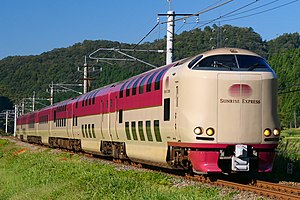The 285 series (285系, 285-kei) is a sleeper electric multiple unit (EMU) train type operated jointly by Central Japan Railway Company (JR Central) and West Japan Railway Company (JR-West) on the overnight Sunrise Izumo and Sunrise Seto limited express services in Japan. These EMUs were introduced from 10 July 1998 to replace ageing locomotive-hauled "Blue Train" coaches which once operated on separate Seto and Izumo services between Tokyo, Shikoku and the Sanin region.[1]
| 285 series | |
|---|---|
 285 series on a Sunrise Izumo service, October 2022 | |
| Manufacturer | Kawasaki Heavy Industries, Nippon Sharyo, Kinki Sharyo |
| Family name | Sunrise Express |
| Constructed | 1998 |
| Entered service | 10 July 1998 |
| Number built | 35 vehicles (5 sets) |
| Number in service | 35 vehicles (5 sets) |
| Formation | 7 cars per trainset |
| Fleet numbers | I1-I5 |
| Operators | JR Central, JR-West |
| Depots | Ōgaki, Gotō |
| Lines served | Tokaido Main Line, San'yō Main Line, Seto-Ōhashi Line, Hakubi Line, Sanin Main Line |
| Specifications | |
| Car body construction | Steel |
| Car length | 21,670 mm (71 ft 1 in) |
| Width | 2,945 mm (9 ft 7.9 in) |
| Height | 4,090 mm (13 ft 5 in) |
| Maximum speed | 130 km/h (80 mph) |
| Traction system | Variable frequency (3-level IGBT) |
| Power output | 1,760 kW |
| Power supply | 1,500 V DC |
| Bogies | WDT58, WTR242 |
| Braking system(s) | Dynamic brake, regenerative brake, electronically controlled pneumatic brakes |
| Safety system(s) | ATS-P, ATS-SW |
| Track gauge | 1,067 mm (3 ft 6 in) |
| Notes/references | |
This train won the 42nd Blue Ribbon Award in 1999. | |
Livery
editThe trains are finished in a livery of "Morning Glow" red and "Morning Mist" beige with "Sun Rise" gold lining. [2]
Formations
editAs of 1 April 2015[update], the fleet consists of five sets, numbered I1 to I5.[3] I1 to I3 are owned by JR-West, and are classified 285-0 series. Sets I4 and I5 are owned by JR Central, and are classified 285-3000 series (the individual cars are numbered in the 3000 range). All sets, I1 to I5, are composed as follows, with two motored ("M") cars and five non-powered trailer ("T") cars.[3] Car 7 and 14 is at the Tokyo (eastern) end.[3]
| Car No. | 1/8 | 2/9 | 3/10 | 4/11 | 5/12 | 6/13 | 7/14 |
|---|---|---|---|---|---|---|---|
| Designation | TNWC' | TNW2 | MN | TNWS | MN2 | TNW | TNWC |
| Numbering | KuHaNe 285 | SaHaNe 285-200 | MoHaNe 285 | SaRoHaNe 285 | MoHaNe 285-200 | SaHaNe 285 | KuHaNe 285 |
The cars of JR Central sets I4 and I5 are numbered in the -3000 series.[3] The motor cars are each fitted with one WPS28A single-arm pantograph. The motor cars in sets I1 and I3 each have two.[3]
Interior
editEach car includes toilet facilities.[3]
-
B single-twin berths
-
B single berths
-
Nobinobi floor space (Upper)
-
Nobinobi floor space (Lower)
-
Mini saloon area
Fleet details
editThe individual build details of the fleet are as shown below.[3]
| Set No. | Manufacturer | Date delivered |
|---|---|---|
| I1 | Kinki Sharyo | 19 March 1998 |
| I2 | 15 April 1998 | |
| I3 | Kawasaki Heavy Industries | 1 May 1998 |
| I4 | Kinki Sharyo | 8 April 1998 |
| I5 | Nippon Sharyo | 24 April 1998 |
History
editThe trains entered service on 10 July 1998, with set I4 forming the down Sunrise Izumo, set I5 forming the down Sunrise Seto, set I3 forming the up Sunrise Izumo, and set I2 forming the up Sunrise Seto.[3]
See also
edit- 583 series, the first Japanese sleeping-car EMU type
References
edit- ^ JR特急列車年鑑2014 [Limited Express Annual 2014] (in Japanese). Tokyo, Japan: Ikaros Publications Ltd. 20 December 2013. pp. 44–45. ISBN 978-4-86320-793-6.
- ^ 新しい寝台特急電車のカラープラン決定について [Colour scheme for new sleeping car trains]. News release (in Japanese). Japan: West Japan Railway Company. 24 December 1997. Archived from the original on 5 February 1998. Retrieved 24 July 2015.
- ^ a b c d e f g h JR電車編成表 2015夏 [JR EMU Formations - Summer 2015] (in Japanese). Japan: Kotsu Shimbunsha. 20 May 2015. p. 194. ISBN 978-4-330-56915-4.
External links
edit- JR Central 285 series (in Japanese)